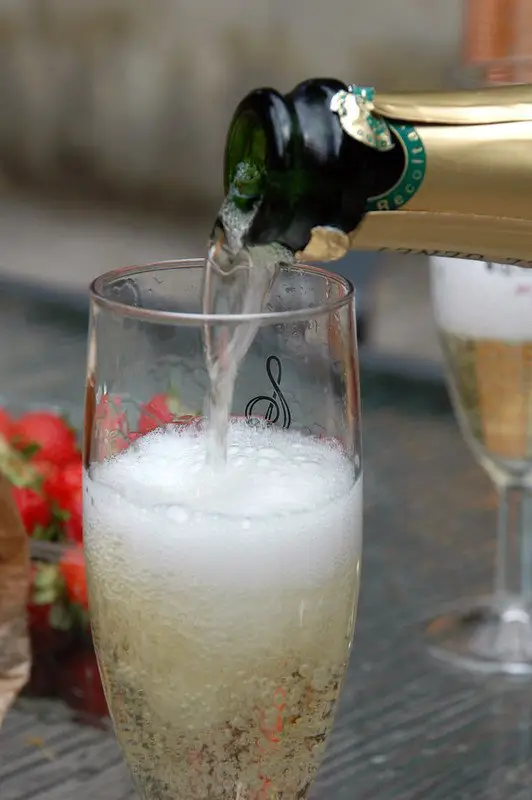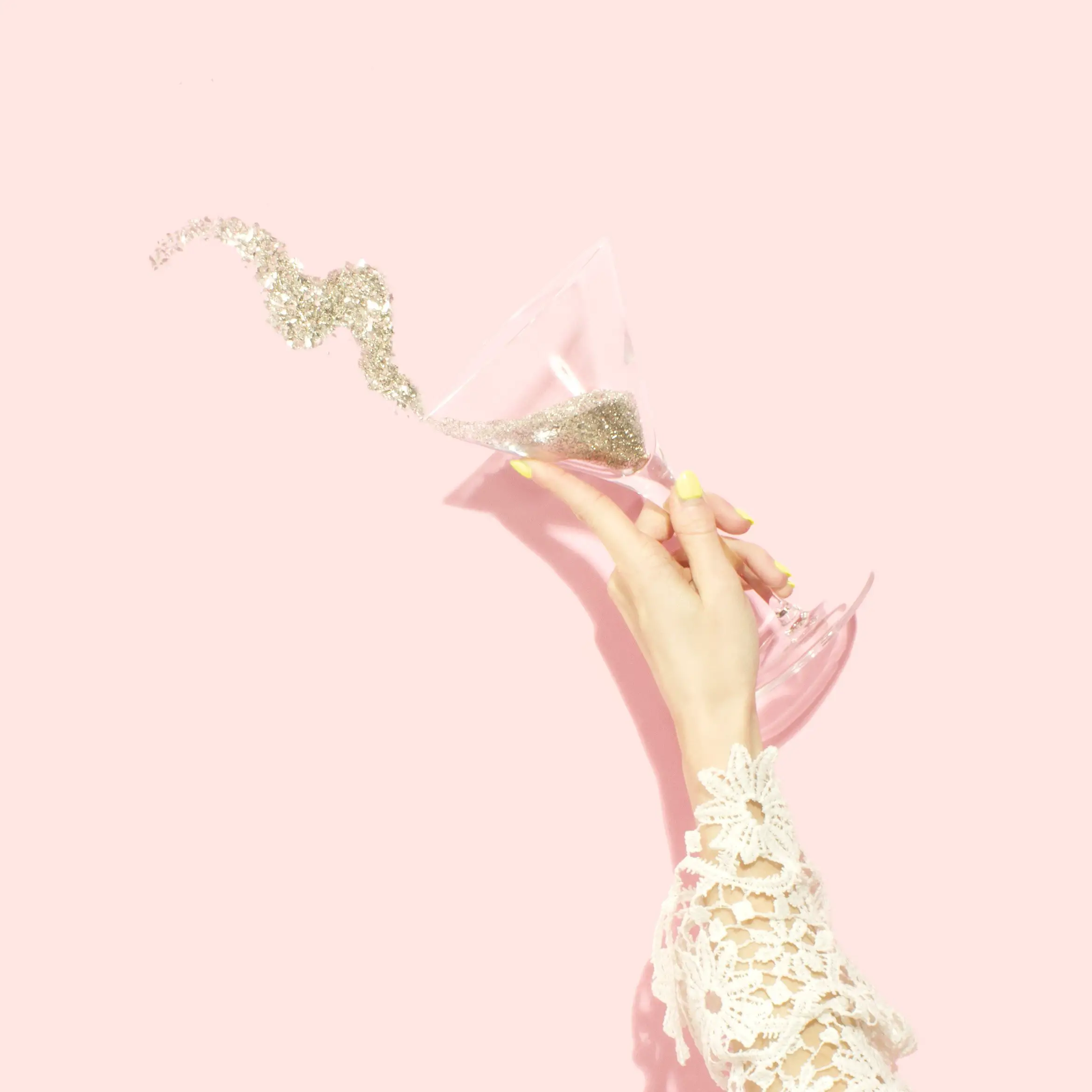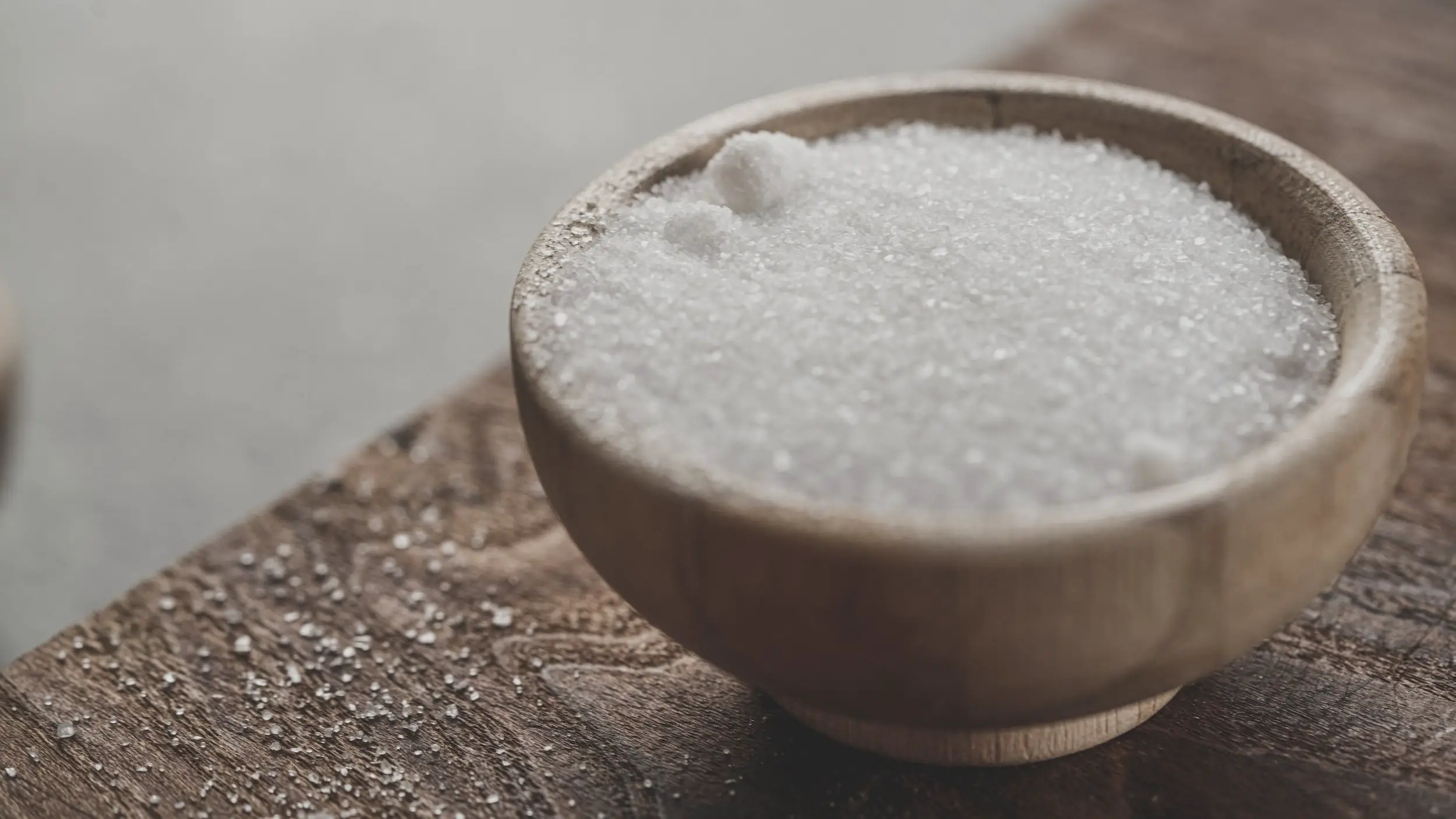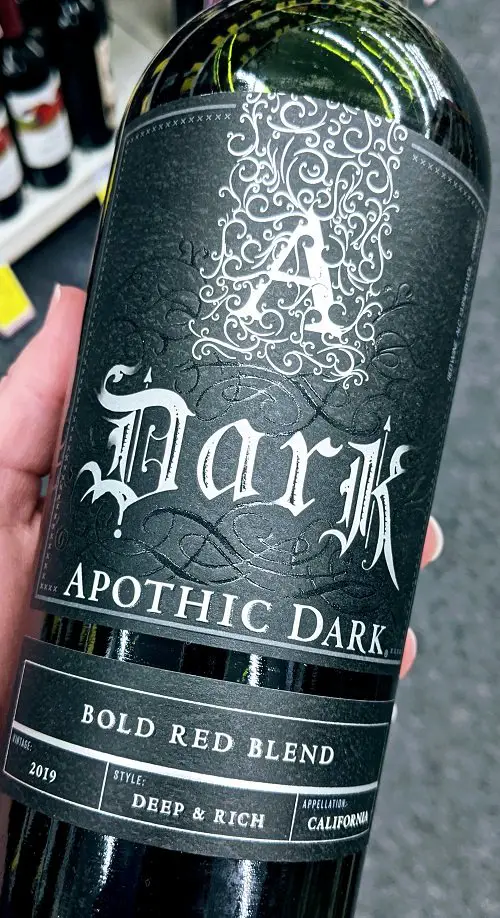
Champagne’s one of those complicated wines where a simple answer never suffices.
Champagnes can be sugar-free (e.g., Brut Nature) or have varying sugar levels (e.g., Doux). Most contain 9-12g/L to balance high acidity. A standard glass of Champagne has around ½ tsp of sugar (0.42 – 0.56 tsp).
But why does Champagne even have sugar? Where does it come from? And how does Champagne’s sugar compare to sugar in regular wines?
Here’s what you need to know.
- How Much Sugar’s in a Glass of Champagne?
- Why Does Champagne Have Sugar?
- What Champagne has the lowest amount of sugar?
- How Much Sugar Is in a Bottle of Champagne?
- Does Champagne Have More Sugar than Regular Wine?
- How Much Sugar Is in Popular Wines
- How Many Spoons of Sugar Are in Champagne?
- Is Champagne Pure Sugar?
- How Do I Find Out How Much Sugar Is in My Champagne or Wine?
- Thirsty for More?
How Much Sugar’s in a Glass of Champagne?
| Dosage Level | Sugar Content (g/L) |
|---|---|
| Zero Dosage/Brut Nature | 0-3 g/L |
| Extra Brut | 0-6 g/L |
| Brut (Dry) | 0-12 g/L |
| Extra Dry | 12-17 g/L |
| Sec/Dry | 17-32 g/L |
| Demi Sec/Medium Dry | 32-50 g/L |
| Doux/Dulce/Sweet | 50+ g/L |
Champagne, the European Union, and most other sparkling wine-producing regions use a standardized scale to break down sweetness levels in sparkling wines that refers to how much sugar’s in your Champagne.
Helpful Tip: Sweetness in wine most often means ‘residual sugar’. Residual sugar’s a technical term in winemaking and is the amount of sugar in a wine that’s not fermented into alcohol. You measure this in grams per liter, as in: A wine has 5g/L of RS (or sometimes you’ll see this as r/s). The higher the residual sugar, the more grams of sugar per liter, and the sweeter the resulting wine. Sugar can come from unfermented grape juice or sugar that’s added to the wine before bottling. Check out this helpful post on why your wine’s sweet.
I’m not sure how helpful the Champagne/EU sweetness level breakdown is for the average wine drinker, but I can see where knowing how much sugar’s in wine can be important if you’re watching calorie intake or have other dietary concerns.
Zero Dosage or Brut Nature Champagnes have 0-3 g/L of residual sugar. This means that the winemaker added zero sugar to the Champagne. Any sugar that happens to be left over in the wine comes from the original grape juice that didn’t fully convert into alcohol through wine fermentation.
Jargon Alert: Dosage (pronounced doe-SAW-sh) is a French sparkling winemaking term. The dosage is a small mixture of wine and sugar added to Champagne and other traditional method sparkling wines right before corking the bottles with a mushroom cork. So Zero Dosage means no sugar added.
What’s confusing about the Champagne and EU sweetness level breakdown is that as a wine drinker you actually have no idea what the sugar level is in your Champagne between Zero Dosage, Extra Brut, and Brut unless it’s on the bottle or you go onto the producer’s website and look it up (assuming it’s on a website somewhere).
Technically, you could buy a Champagne labeled Brut that has 0 g/L and no added sugar.
This is unhelpful.
Tasting Tip: Learn how to figure out if your wine is dry or sweet with this helpful post.
Why Does Champagne Have Sugar?

Most Champagnes and other sparkling wines have some amount of sugar in them. This is because sparkling wines use barely ripe grapes with very high acid levels. The added sugar helps balance out what could otherwise be a wincingly sour Champagne experience.
Fun Fact: Champagne and sparkling wines have such high acidity that you may not even be able to detect the sugar added to the wine, even if it’s definitely in the wine.
I regularly misidentify the sweetness level when I’m blind-tasting sparkling wines. I’ll taste a sparkling wine that has 9-12 g/L sugar and will pronounce it dry.
Sparkling wines are that acidic.
What Champagne has the lowest amount of sugar?

If you’re wondering what Champagne has the least amount of sugar, then look for Champagne, Cremant, or other sparkling wine labels with Zero Dosage or Brut Nature. These two Champagne styles will have the least amount of sugar in them at 0-3 g/L.
A standard 4 oz glass of Zero Dosage or Brut Nature Champagne or sparkling wine will have a maximum 0.14 tsp (a little over ⅛ tsp. per standard glass), or it could have no sugar at all!
Good news!
Brut Nature and Zero Dosage sparkling wines are growing in popularity, so you should be able to find a bottle of this austere bubbly in a wine shop near you.
How Much Sugar Is in a Bottle of Champagne?

Most champagnes and other sparkling wines have between 9 and 12 grams per liter of sugar, this translates into 6.75 and 9 grams of sugar per standard 750 ml Champagne bottle.
Does Champagne Have More Sugar than Regular Wine?

If you drink small-production dry red or white table wines, then it’s likely that your Champagne has more sugar than your average table wine. If you drink inexpensive, popular wines with wide distribution, it’s likely that they have more sugar than Champagne.
Some popular mainstream wine labels in the US market have significant sugar in them, and your Champagne may actually have less sugar than those wines.
Here are some popular red table wines in the US that have significant sugar in them:
How Much Sugar Is in Popular Wines
| Wine | Sugar Content (g/L) |
|---|---|
| Meomi Pinot Noir | 15 g/L |
| Apothic Red | 16.4 g/L |
| Yellowtail Red | 12 g/L |
| Cupcake Red Velvet | 13 g/L |
| Menage à Trois Red | 12 g/L |
Sugar in wine provides weight, body, and mouthfeel, in addition to smoothing out the rough edges of acid and tannin. Sugar’s the secret ingredient. They enjoy broad, popular appeal as velvety, buttery red wines thanks to sugar.
So has Champagne got less sugar than wine?
According to the Champagne and EU sweetness levels in wine, Champagne can definitely have higher sugar levels than regular wine.
Dry, Demi-sec, and Doux Champagnes have significant sugar (17-50+ grams per liter). But the most popular Champagne style, Brut, can have less sugar than some major wine labels.
How Many Spoons of Sugar Are in Champagne?
Most Champagnes and sparkling wines are made in a Brut (dry) style, which means that your standard glass of Champagne will have around half a teaspoon (½ tsp or .55 grams) of sugar. This is about 1/2 the weight of a paperclip. Not very much!
Compared to adding sugar to your tea, or a glass of juice, or certainly compared to soda or cola, there’s not much sugar in your glass of Champagne.
Is Champagne Pure Sugar?

Contrary to what you might think, most Champagne doesn’t have much sugar. But, to be fair, sugar can be used in 3 key stages of sparkling wine production: right before fermentation, right after fermentation to create bubbles, and before the bottle’s corked for sale.
Tip: Check out this helpful post on wine fermentation to learn how sugar’s converted to alcohol.
- Before Fermentation: You may hear about sparkling winemakers adding sugar to the grapes before fermentation. This sugar gets converted to alcohol; so, it’s no longer sugar. Winemakers do this because Champagne and sparkling wine grapes often come from very cool vineyards where they hardly ripen. Winemakers have to add sugar to ensure the wine meets minimum alcohol levels.
Jargon Alert: Adding sugar to grape juice before fermentation is called chaptalization. The practice has been used for centuries. Curiously enough, all of the sugar seems to disappear from my local store shelves right around harvest time. Someone’s busy chaptelizing around here! 🙂
- After Fermentation: Sugar’s added right after fermentation along with a little yeast to each bottle of Champagne. The yeast will metabolize this sugar and create CO2, or the bubbles we all love in Champagne. All of this sugar’s metabolized, so it doesn’t make the wine sweeter.
- Before Bottling: Sugar added right before bottling will adjust the Champagne’s sweetness and reduce the wine’s steely acidic profile. This is the dosage described above.
How Do I Find Out How Much Sugar Is in My Champagne or Wine?
Wine producers in the US aren’t required to list sugar levels in wine (not even imported wines), so most bottles won’t have sugar listed, unfortunately. Large producers and good wineries put tech sheets (technical sheets) for their wines online.
Type in “Wine Name Tech Sheet” in any search engine and you’ll be able to find out lots of interesting information about the wine, how it was made, and nutritional information including residual sugar.
Curiously, there’s a trend with younger consumers being more health-conscious. Today, you’ll see wine labels that list “0 SUGAR” on their labels, or maybe “1 g of Carbs”. These producers are trying to appeal to this emerging market. This is a fantastic trend if you’re conscientious about health information on your wine labels.
Thirsty for More?
Check out this post on Is Prosecco Just Cheap Champagne?
Here are 15 fun Champagne facts that explain why these bubbles cost so much, and much more!




